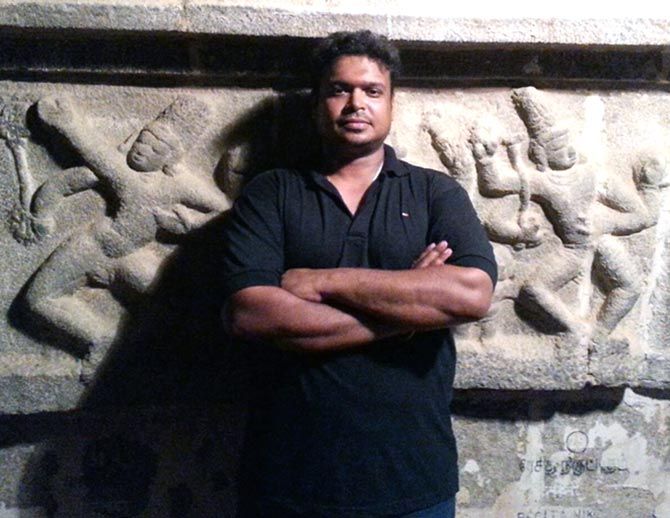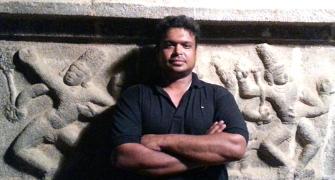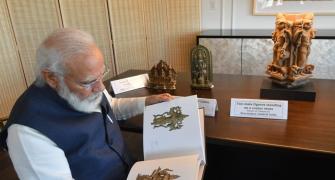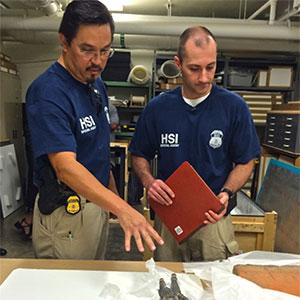'In China there is capital punishment for heritage theft. That is how they treat criminals, unlike us.'
'Here we treat them like it's a house-breaking theft.'

Vijay Kumar Sundaresan has been showered with praise on social media since Prime Minister Narendra Damodardas Modi posed in New York with 157 stolen ancient artefacts that were being returned to India.
Sundaresan is the co-founder, India Pride Project and author of The Idol Thief.
These 157 artefacts were looted from different parts of India at different times and after a lengthy legal battlein the US, these Indian treasures were finally heading back home.
Sundaresan spoke to Syed Firdaus Ashraf/Rediff.com about how India got back its ancient treasures from the US.
You have become a star on social media as everyone is crediting you for getting India's ancient artefacts back and acknowledging your efforts. You have been fighting this battle for more than a decade now, so it must feel good.
I am grateful to my team as we are a volunteer-based project. When we started the India Pride Project in 2014 the core team and all the volunteers decided that this cause will not be for any rewards. We run this project without a single rupee or dollar contribution from anybody.
For us true reward is when our murtis (idols) come back. I am happy.
I am the face behind this projec,t but there is an entire team working behind me to get the murtis back to India.
For obvious reasons of safety, as many of my volunteers are inside the art market, their faces or names cannot be revealed. There are some on the ground exposed to the collectors' lobby, cartels and robbers. For various reasons, they choose to remain anonymous. My gratitude and thanks to my volunteers.
The second gratitude from my side is to our US team as these are sacred objects coming back to our country.
India owes its gratitude to Matthew Bogdanos, assistant district attorney, New York, and another lady of Indian origin, Apsara Iyer.
I met Iyer in 2016 at a conference and that time she was an arts student and very much interested in the arts market. She has been working with us and law enforcement agencies of India, the ASI (<em), and putting in a lot of effort for these restitutions.
You do not expect someone who has paid millions of dollars for these artefacts to return them to India. This requires a lot of background work and wherever we have staked our claim (to stolen ancient artefacts), we have got them back and our claim has withstood the scrutiny by law.
These 157 artefacts, how did you identify them?
We were expecting more. This was promised by the USA in 2016 during PM Modi's previous visit. But we are still happy to get these 157 artefacts.
If you take the CAG (Comptroller and Auditor General) report of 2013, you will find that from 1947 to 2000, India brought back only 19 (stolen) artefacts from abroad.
From 2000 to 2012 the number was zero. After which we started a lot of background work and we got all the necessary traction from state governments and the Archaeological Survey of India.
International law enforcement agencies too started taking us seriously. After which from 2013 a lot of restitutions started happening.
And I am quite happy that we have crossed 53 items since then and if you add these artefacts then we have crossed 200 artefacts.
About 95 percent of the artefacts that have come back since 2012 have been tracked by my team or we worked with law enforcement agencies.
Are any of these 157 artefacts from the collection of art smuggler Subhash Kapoor?
A majority of them are from art smuggler Subhash Kapoor's artefacts. He was arrested in 2011 after an Interpol red corner alert. His houses were raided in an operation and (artefacts) seized by Homeland Security.
As of 2012, his holding stock of 2,622 artefacts in New York is valued at US$108 million. This was from known locations and holding stock. He and his sister have hidden a lot more. A majority of them are Indian artefacts but there are other countries' artefacts too.
The USA in the last six months has done restitution of artefacts to other countries too, like Pakistan, Afghanistan, Cambodia, Thailand and Sri Lanka. I have chronicled them in my book The Idol Thief -- The True Story of the Looting of India's Temples.
Once a museum pays money to art smugglers like Subhash Kapoor without knowing the artefact was smuggled, why would they return the idols because they have already paid the money?
There is a United Nations Convention of 1970 which says that whenever a country can prove that an 'object' was removed illegally from that country after 1970 and is in possession of the holding nation, then the 'object' has to be returned.
It is just that we as a nation have to prove the illegal theft. The other side gets 30 days to refute India's claim and prove ownership.
If they fail to do so, then there is no way they cannot return the stolen items.
No thief can give you a genuine title. If you cannot prove it is not a stolen title, then you lose your claim to that title.
I am not saying that 1970 is the Lakshman Rekha for stolen objects because India had such a law from 1878. It is just that we need to go to court and be more aggressive and push more.
Frankly, if we prove it we will get our stolen items but we do not have a national squad for (doing such things). We do not have laws, registers or archiving of our (ancient) areas.
Plus, if Indian citizens can come and report the theft even as far back as 1960, we can get the artefacts back.

For example, we cracked the theft from The Netherlands where a Buddha statue was to be sold in an art fair. In 2018 we got that Buddha statue back from The Netherlands after 57 years.
We have to be more aggressive as the burden of proof is on the current seller. We just have to ask the seller, of say an artefact like a Gupta era statue or Chola period statue or some painting of Indian origin, to show that s/he is the legitimate owner.
We need to ask the seller to show the legitimate export details from India before 1970. After 1970, the chapter is closed. You cannot export any antiquity over 100 years out of India.
As a nation if we become more enforcing of our claim, we can stock a lot (of our ancient antiquity). In fact this has happened, we have done great work in Australia and they have returned US$40 million of art work back to India.
Australian public museums have restricted themselves from buying anything of Indian origin anymore (because of the fear that they maybe smuggled).
Sadly, we did not care in the past and that is what we want to change. We will fight back to get back our artefacts.
What is the worth of these 157 artefacts?
Priceless! But if you want to put a price it would be around US$30 million to US$40 million as this was the price that the robbers wanted to put on these artefacts for sale in the market.
Is there any Website or data giving details of which ancient artefacts have been stolen from India and from which state?
After India signed the 1970 'UN Convention on the means of prohibiting and preventing the illicit import, export and transfer of ownership of cultural property', we were supposed to maintain it.
India and Italy used to have reported thefts. I am using the word 'reported thefts' because only five percent of the thefts, of the actual thefts, were being reported for various reasons because people do not want to report thefts. That number counting somehow stopped after 1976.
In my assessment, India is losing 10,000 major artefacts per decade.
10,000 is a huge number...
I am not plucking this number out of thin air. For example, Subhash Kapoor was a mid-sized dealer and in business for 35 years. His holding was 2,622 objects and that too unsold stock.
Similarly, there is a submission by the Hindu Religious and Charitable Endowments as they are the custodians of 38,000 temples in Tamil Nadu. There is a court case going on where they say that in the period between 1992 and 2012, they reported 1,200 idols missing. This is reported as per submission.
And this in only one state, Tamil Nadu, which properly documents such thefts in these matters.
Now you can take this number and extrapolate the data from other states.

What should we as Indian citizens do to see that our artefacts are not stolen?
The first thing you do is to go to your villages and visit temples of whichever god you believe in.
If you can take photographs (of idols), well and good. If not, please tell the temple custodian to keep the photographs of the idols.
Archiving is the best way to stop art theft.
If you do that and once the murti is archived, then practically that murti becomes unsaleable in the international market provided we police the market.
In your travels to Paris or Amsterdam or any other country, if you see any Indian art on sale, look for the provenance (chronology of ownership), take a photograph and reach out to us. We will take action (if it is illegal).
If you cannot take a photo, please alert us by sending a mail and we will take action. We have been doing that for the last 10 years.
From the government side we need a large squad. Italy and India signed the UN convention together and Italy have their own central art squad under their ministry of defence. They have got back over a lakh of objects to their country. It is their success story.
India started with a squad in Tamil Nadu in 1984 which had 900 members and which came down to three people in 2010. It is coming up in a small way.
Kerala has a temple protection force which has not done anything and Karnataka had one with much fanfare two years ago but nothing came out of it.
India has to get a central squad. Today, if someone breaks into a temple and steals idols, the only Indian Penal Code section that will apply will be like house theft. And maximum punishment is 6-7 years.
In China there is capital punishment for heritage theft. That is how they treat criminals, unlike us.
Here we treat them like it's a house-breaking theft. In Tamil Nadu in 1993 they brought in an amendment to IPC (Indian Penal Code) section 318 which reduced the sentence for temple theft by half.
The joke is if you break into a house illegally you will get 6 years' jail but in Tamil Nadu if you break into a temple and commit theft you will get 3 years' imprisonment.










